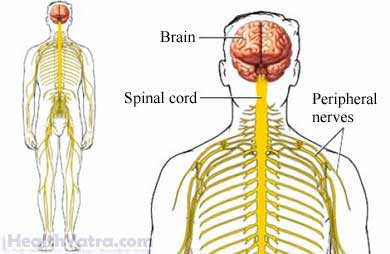تعريف
Myoclonus is a brief and rapid twitching of a muscle or muscle groups. The twitching happens suddenly. It cannot be stopped or controlled.
There are different types of myoclonus. Some occur normally, like the hiccups or a movement while falling asleep. Other types are abnormal. The condition can be classified according to:
- Underlying cause
- Pattern of movement
- Origin within the body
أسباب
The movements are caused by an abnormal electrical discharge in the nervous system. The electrical discharge may begin in the:
- Brain
- الحبل الشوكي
- Nerve in the body
The message travels along the nerves to the muscle. The nerve stimulates a muscle or group of muscles to suddenly contract.

What triggers the abnormal electrical discharge depends on the cause. Myoclonus is often a symptom of a nervous system or metabolic condition. Possible causes include:
- A lack of oxygen or nutrients
- Certain medications or toxins
- Nervous system disorders, such as:
- Head or spinal cord trauma or injury
- Tumors of the brain or spinal cord
- تصلب متعدد
- مرض الشلل الرعاش
- Alzheimer’s disease
- Creutzfeldt-Jakob disease and other prion diseases
- مرض هنتنغتون
- التهاب الدماغ
- سكتة دماغية
- الصرع
- غيبوبة
- Paraneoplastic syndromes—disorders that happen in people with certain types of cancer
- Metabolic disorders, such as:
- Lipid storage disease—a congenital disorder that usually occurs in children
- Electrolyte imbalance
- توقف التنفس
- تليف كبدى
- فشل كلوي
- Malabsorption syndromes, such as Whipple’s disease or celiac disease
عوامل الخطر
A family history of myoclonus is the only common risk factor that has been identified.
الأعراض
Myoclonic symptoms vary from mild to severe. This depends on the cause of the problem. It may begin in childhood or adulthood. The sudden jerking or twitching may occur once in a while or often. It may be limited to one region of the body or affect all muscle groups.
Light, sound, touch, or movement may be triggers. Or, it may happen for no known reason. Movements can occur at rest or during other movements. There may be one or a series of twitches. Sometimes, the jerking occurs in a pattern. Other times, there is no pattern. Myoclonus can become so severe that it interferes with eating, speaking, or walking.
التشخيص
Your doctor will ask about your symptoms and medical history. A physical exam will be done. Your doctor will try to determine the following:
- The localization of the myoclonus in the nervous system
- If an underlying condition is responsible for the symptoms
قد تشمل الاختبارات ما يلي:
- You may have your brain and muscle activity measured and recorded. This can be done with:
- Electroencephalogram (EEG)
- Electromyogram (EMG)
- Pictures may be taken of your bodily structures. This can be done with:
- تصوير الرنين المغناطيسي
- الاشعة المقطعية
- Single photon emission computed tomography (SPECT)
- Blood tests may include:
- Thyroid function
- Blood chemistry
- Complete blood cell count
- Toxicology screen to check for drugs or toxins
- Blood tests looking for other metabolic causes
العلاج
Treatment aims to reduce how severe the movements are. The drugs given depend on the underlying cause. In some case, multiple drugs are needed to reduce twitching. Some have serious side effects.
- Sedatives:
- Lorazepam
- Diazepam
- كلونازيبام
- Piracetam
- Tetrabenazine
- Anticonvulsants:
- كلونازيبام
- Divalproate sodium
- جابابنتين
- Topiramate
- Primidone
- Carbamazepine
- 5-hydroxytryptophan (5-HTP)
- Adrenocorticotropic hormone (ACTH)
الوقاية
Taking these steps may help to reduce your chance of myoclonus:
- Take care to prevent brain injury. For example, wear a helmet when riding a bicycle or motorcycle.
- If twitching begins after starting a new medication, tell your doctor. Your doctor may be able to lower the dose or prescribe a different medication.
